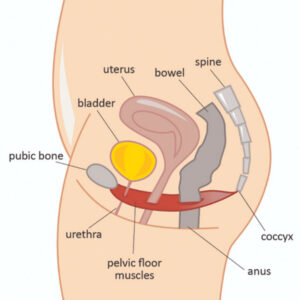Thank you to Kirby Birch from Perform Physio and Pilates on presenting to our wider Inspire community on all things Women’s Health. It was fantastic to see many eager women of all age groups attend and engage in such an important topic.
For those who were unable to attend, below is a summary of Kirby’s presentation. If you want more information, or are curious about women’s health physiotherapy please speak with one of our team.

What is women’s health Physiotherapy?
A specialised area of physiotherapy that focuses on the assessment, diagnosis, treatment, and management of conditions related to the pelvic region in women. We form part of the multidisciplinary team, and often work alongside doctors, gynaecologists, urologists, colorectal surgeons and other allied health professionals.
So, what is the pelvic floor?
 The pelvic floor is a group of muscles, ligaments and tissues that support the pelvic organs, including the bladder, uterus and rectum.
The pelvic floor is a group of muscles, ligaments and tissues that support the pelvic organs, including the bladder, uterus and rectum.
Often referred to as a ‘sling’ or ‘hammock’ of muscles at the bottom of the pelvis. These muscles work as a team to maintain continence and relaxation during urination and bowel movements. They also help support the pelvic organs and have a role in sexual function, too!
There are some risk factors that can predispose people to pelvic floor dysfunction. Some of the notable risk factors are pregnancy & childbirth, menopause and ageing, chronic constipation and straining & many more.
What are some symptoms of pelvic floor dysfunction?
- Any type of urinary or fecal leakage
- Urinary leakage when coughing, sneezing, laughing and exercising
- Needing to get to the toilet in a hurry or not making it in time
- Urinary frequency
- Pain or discomfort when emptying bladder or bowels
- Persistent feelings of pressure or heaviness in the pelvic region
- Pain or leakage with sexual intercourse
- Pelvic pain (can also manifest in low back and hip pain)
- Recurrent UTI’s
Menopause and the pelvic floor
Due to these hormonal changes, many women may notice:
- Pelvic floor muscle weakness (increase in leakage or feelings of urgency)
- Vaginal dryness (can present as itchiness or irritation to the vulval region)
- Increase in urinary tract infections
- Symptoms of pelvic organ prolapse
- Decreased libido
- Painful intercourse
- A ‘less elastic’ bladder, causing someone to empty their bladder more frequently
(Continence Foundation of Australia, 2021)
Before we discuss pelvic floor exercises, it’s important to understand that this is not individual advice and you should speak with a women’s health physiotherapist if symptoms occur.
How do I exercise my pelvic floor muscles?
- Relax your bottom, thighs and abdominals
- Think of squeezing the ring of muscle around your back passage (anus) as if you are trying to stop wind
- Now relax this muscle
- OR imagine you are stopping the flow of urine on the toilet, and then start the flow again
- Remember that we are trying to isolate the internal muscles
- Should feel like an internal “squeeze and lift”
Common mistakes: breath holding, squeezing abdominals and bottom muscles to help, forgetting to ‘relax’. When done right, no one should know you are exercising your pelvic floor muscles at all.
Pelvic floor in the gym setting
- Any leakage with exercise is not normal and shouldn’t be ignored
- Avoid breath holding in the presence of dysfunction
- Reconsider timing of high impact training with symptomatic prolapse or leakage
- General exercise and fitness is crucial for optimal pelvic floor functioning
Myth: crunches are bad for your pelvic floor
Truth: standing up from a chair places more pressure on your pelvic floor than a crunch
Continence Foundation of Australia – enormous amount of educational resources for the general public as well as health practitioners: continence.org.au
For individual advice speak to your treating health practitioner
